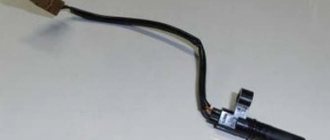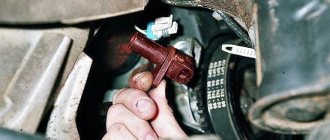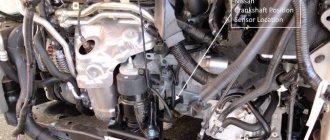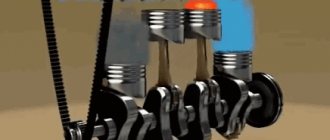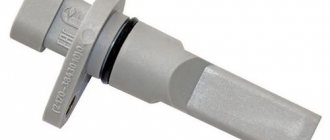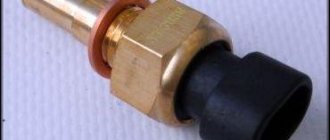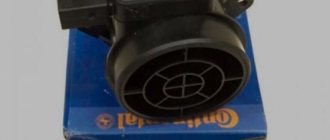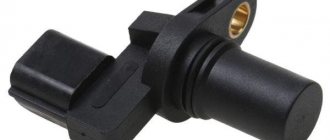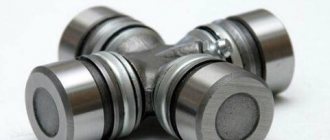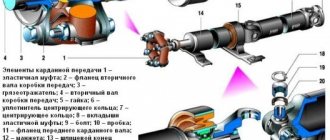It often happens that you blame the car for engine failure, low-quality fuel that was filled at a gas station, although in fact the input shaft speed sensor in the automatic transmission simply failed. Damage can be mechanical, destruction of the seal of the housing, or internal, oxidation of contacts. But first things first.
Write in the comments, has this device already failed?
Automatic transmission input shaft speed sensor
The automatic transmission is equipped with two speed sensors.
- one records the number of rotations of the input shaft;
- the second one measures it.
Attention! For automatic transmissions of variable-wheel drive vehicles, the sensor measures the number of rotations of the differential gear.
The input shaft sensor is a magnetic non-contact device based on the Hall effect. Consists of a magnet and a Hall integrated circuit. This equipment is packaged in a sealed case.
Information from these sensors goes to the electronic control computer of the machine, where it is processed by it. If any malfunctions are observed either with the sensor, or with the crankshaft or differential, then the automatic transmission goes into emergency mode.
If the ECU does not find any problems according to the sensor readings, and the car speed drops or does not pick up, the Check Engine light is on, then perhaps the fault is in the automatic transmission input shaft sensor itself. But more on that later.
Read
Installation of an external main automatic transmission filter and its functions
Now I will talk about how the input shaft sensor works.
Principle of operation
As I already wrote, the device records the number of shaft revolutions after switching to one of the automatic transmission gears. The working process of the Hall sensor is as follows:
- During operation, the electromagnetic sensor creates a special electromagnetic field.
- When a wheel protrusion or a gear tooth of a “pulse wheel” installed in it passes through the sensor, this field changes.
- The so-called Hall effect begins to operate. In other words, an electrical signal is generated.
- It is converted and sent to the automatic transmission electronic control unit.
- Here it is read by a computer. A low signal is a trough, and a high signal is a ridge.
The “impulse wheel” is a regular gear installed in the device. The wheel has a certain number of protrusions and depressions.
Where is
The sensor for measuring the speed of the automatic transmission output shaft is installed on the machine body next to the air filter. Devices for measuring the number of rotations of the input and output shafts differ according to the number specified in the catalog. For Hyindai Santa vehicles they have the following catalog values: 42620 and 42621.
Attention! These devices should not be confused. There is a lot of information on the Internet about these devices, but often inexperienced writers do not distinguish between them and write as if they were one and the same thing. For example, information from the last device is needed to adjust the lubricant pressure. These automatic transmission sensors have different proportions between the speed and the signals that come from them.
It is these devices that immediately communicate with the automatic transmission control unit. The devices themselves are repairable. You just need to check if there are any cracks on the body.
Read
Diagnostics and repair of automatic transmission selector position sensor
Next, I will tell you about diagnosing problems with the input shaft rotation speed sensor.
Diagnostics
If you are a new car enthusiast and don’t know how to check, and where to start looking for errors in the device, I advise you to ring the contacts and measure DC or AC signals. For this you use a multimeter. Use the tool to determine voltage and resistance.
Diagnostics can also be carried out by the shocks and jerks that the driver feels when switching the selector lever to mode “D”. A faulty sensor gives incorrect signals about rotation measurements and, accordingly, weak or too high pressure is created, which causes failures in speed gain during acceleration.
Experienced mechanics include monitoring the appearance of errors on the dashboard monitor as a visual type of diagnostics. For example, the following lights on the monitor may indicate problems with the input shaft sensor:
- "Check Engine";
- The “Hold” lamp blinks.
The automatic transmission can start emergency mode, or only engage 3rd gear and nothing else.
If you check with a scanner with a laptop in your hands, the following error “P0715” will be displayed. In this case, you need to either replace the automatic transmission input shaft sensor or replace the damaged wires.
Let's sum it up
As you can see, the automatic transmission shaft speed sensor is a simple element, and the quality of operation of the automatic transmission as a whole directly depends on its serviceability. If any malfunctions and deviations from the norm are noticeable (the car accelerates poorly, the “check” light comes on, the HOLD indicator blinks, gears shift hard and roughly, the shift timing is shifted, delays are observed, etc.), then as part of a comprehensive automatic transmission diagnostics One should not exclude possible malfunctions of the automatic transmission input shaft speed sensor.
We also recommend reading the article about what automatic transmission sensors exist. From this article you will learn about the main sensors that are used in the design of the automatic transmission. Finally, we note that this part for most cars with an automatic transmission is not very expensive. In other words, if it is precisely established that the sensor indicated above is faulty, then it is optimal to replace it with a new one instead of attempting a makeshift repair.
In this case, the replacement itself can be done on your own in a garage. The main thing is to separately study in the manual all the necessary information regarding the installation location, features of removal and subsequent installation of the automatic transmission input shaft sensor.
Source
Measuring the rotation of the automatic transmission output shaft
I wrote earlier about the sensor for measuring the rotation of the output shaft of an automatic transmission, comparing it with the device that records the rotation speed. Now let's talk about its malfunctions.
A malfunction of the output shaft speed sensor is indicated by error P0720. The box ECU receives a signal from the device and decides what next speed to turn on. If there is no signal from the sensor, the automatic transmission goes into emergency mode or an experienced mechanic diagnoses error 0720 with a scanner.
Read
Installation and repair of automatic transmission oil pump
But first, the driver may complain that the car is stuck at one speed and does not change gears. There are failures in acceleration.
Write in the comments if you had problems with devices for determining the rotation speed of the input and output shafts, what errors the automatic transmission gave you.
Let's sum it up
As you can see, the automatic transmission shaft speed sensor is a simple element, and the quality of operation of the automatic transmission as a whole directly depends on its serviceability. If any malfunctions and deviations from the norm are noticeable (the car accelerates poorly, the “check” light comes on, the HOLD indicator blinks, gears shift hard and roughly, the shift timing is shifted, delays are observed, etc.), then as part of a comprehensive automatic transmission diagnostics One should not exclude possible malfunctions of the automatic transmission input shaft speed sensor.
In this case, the replacement itself can be done on your own in a garage. The main thing is to separately study in the manual all the necessary information regarding the installation location, features of removal and subsequent installation of the automatic transmission input shaft sensor.
The main sensors in an automatic transmission: the purpose and operating principle of automatic transmission sensors. Malfunctions of automatic transmission sensors, signs.
What is automatic transmission emergency mode? Why does the automatic transmission go into emergency mode: the reasons why the automatic transmission goes into emergency mode, diagnostics.
Why the automatic transmission kicks, the automatic transmission jerks when changing gears, jerks, jerks and impacts occur in the automatic transmission: the main reasons.
Automatic transmission slipping when changing gears: the main reasons why an automatic transmission slips. Box diagnostics, troubleshooting.
Automatic transmission ECU: how the electronic control unit of an automatic transmission works and works. Malfunctions of the automatic transmission ECU, repair of the control unit.
How an automatic transmission works: classic hydromechanical automatic transmission, components, controls, mechanical part. Pros and cons of this type of gearbox.
Source
Gear shift detection
Now you know everything about the sensors that monitor the rotation speed of the input and output shaft. Let's talk about another very important device - a device for determining gear shifts. It is located next to the selector. The choice of speed and the ability of the driver to engage one or another gear depend on it.
This device monitors the position of the gear selector linkage. But sometimes it breaks down and then the driver observes:
- incorrect indication of the selected gear on the dashboard monitor;
- the letter of the selected gear is not displayed at all;
- switching between speeds occurs in jerks;
- delayed gear shift response. A car, for example, can stand for some time before moving in a given mode.
All these malfunctions occur due to:
- drops of water getting inside the housing, immediately breaking the seal;
- dust on contacts;
- wear of contact lamellas;
- contact oxidation or contamination.
To correct errors caused by improper operation of the sensor, the device must be disassembled and cleaned. Use regular gasoline or kerosene to clean contacts. If you need to solder the loose contacts, then solder them.
Read
Basic malfunctions and repairs of automatic transmission Skoda Octavia
Use a penetrating lubricant to clean the contacts. But experienced mechanics and I do not recommend lubricating the surface with Lithol or Solid Oil.
Causes of malfunctions
There are a number of reasons that directly affect the performance of the device, but do not require its replacement:
- Dirty or worn contacts;
- Moisture getting on the wires;
- Oxidation.
In order to correct the situation, it is recommended to use gasoline to clean the contacts and, if necessary, use soldering of wires.
In other cases, it is necessary to replace the device with a new one. To do this, you can use specialized centers or deal with the issue yourself.
The device is replaced on cars every 100 thousand kilometers. Its cost is about 1000 rubles, but if you don’t want to buy a new one, you can always try to repair the device.
Features of obtaining data on the position of selectors in some car models
The following vehicle modifications have repairable sensors:
- Opel Omega. The slats on the devices for determining the position of the selector levers are thick. Therefore they rarely fail. If they crack, then light soldering reconnects the contacts;
- Renault Megane. Car owners of this car may experience a jammed input shaft sensor. Since the board is packaged in fragile plastic, which very often melts under high temperatures;
- Mitsubishi. Input shaft sensors on Mitsubishi automatic transmissions are famous for their reliability. To correct their poor performance, you need to disassemble it and blow it with air and clean the contacts with kerosene.
If cleaning or blowing the automatic transmission input shaft sensors does not help, you will have to replace it. Have you ever replaced such devices? If not, then sit down comfortably. I'll tell you how to do it yourself.
Neutral sensor on a manual transmission: types, autostart, installation, adjustment
The neutral sensor on the manual transmission installed in the car will start the engine at the right time with neutral speed and the brake raised. A small device in the gearbox will save you from repeating unnecessary actions.
About autorun
Autostarting the engine in winter is a common and not troublesome task for owners of cars with an automatic transmission. Car alarms provide a special arming algorithm with auto start for vehicles with manual transmission.
Security with start is activated only when the engine is running, and in 30 seconds you need to leave the cabin, close the door and have time to press the remote control button. Otherwise, the car will stall and the engine will not start after a certain time interval, despite the alarm working. When you open the doors again after setting the alarm, the algorithm is also broken and the car will no longer start automatically.
Negative effects of soft neutral
In the alarm settings, especially for cars with a manual transmission, you can select the “Automatic transmission” mode - program neutral. In this case, forgetful and inattentive drivers, out of habit, leave the car at the speed at which they parked. However, many people neglect the handbrake. The alarm starts the engine to warm up. The speed is already set, the handbrake does not work - and an uncontrollable car can lead to unforeseen events and tragedies.
Car owners, after 30 seconds of manipulation with automatic engine start, remember things forgotten in the car. And they are forced to take repeated actions that they took 2 minutes ago. And there are many examples of the fact that a motorist, after “entering” the car again, forgets to turn on the ignition so that the engine starts, and is left the next morning with a frozen engine.
Neutral sensors
Sensors that start the engine come to the rescue when the gear lever is in neutral and the brake handle is raised.
Types of sensors
There are several types of sensors, which will be discussed below.
Reed switch
According to many users, this is one of the best sensors that does not require additional power to operate. A device that opens and closes an electrical network under the influence of a permanent magnet generating an electromagnetic field. The name of the device comes from the merger of two words, since the contacts are sealed in a vacuum glass tube, or in a tube with an inert gas, which prevents a spark from occurring.
The scope of application of the reed switch is wide, despite the fact that it is now being replaced by the Hall sensor, which is simpler in design, but requires an electrical network. Reed switches are used in household meters, security and control systems, in devices related to underwater and water works, in complex medical equipment, and in high-voltage electrical installations.
Divided by:
- closed – the magnetic field opens the circuit;
- switchable - the magnetic field closes and opens the contacts depending on the absence or presence of a magnetic field;
- open – the magnetic field affects the operation of the circuit.
Kinds:
- gas - a glass flask filled with an inert gas;
- mercury - mercury applied to the contact plates improves communication quality, eliminates vibration and reduces resistance.
Disadvantages of using a reed switch:
- short service life.
- contacts become unusable.
- signals arrive at a poor speed, which causes alarms to be triggered once again.
Slit optical device
Using this sensor in a gearbox as a regulator is a reasonable solution. Since the device, consisting of two parts: an emitter and a receiver, connected in the shape of the letter U, is easy to use. The slot in the sensor body is the working area. An opaque object or part that falls into this zone opens the circuit.
The receiver is an LED, photodiode, phototransistors or Darlington transistor. Used in high-speed installations, conveyors, and produced for installation in the ignition key of racing motorcycles. Installing and replacing the sensor does not require much time. May react to dust, gas, water and smoke. This circumstance can lead to serious problems when starting the engine if the lever is in speed.
Inductive non-contact device
Its purpose is to control the position of metal objects or objects. Other materials do not respond to the inductive device. A reliable, high-quality device is used in industries related to the manufacture and production of machinery, transport, and food products. There are cylindrical and box types.
The device consists of:
- a generator that creates an electromagnetic field and interacts with an object;
- a Schmitt trigger that switches different parts of the sensor;
- signal amplifier;
- LED helps monitor switch status and performance;
- compound for protection from external influences;
- housing that protects against mechanical impact. Equipped with fastening parts.
How it works: The generator is the main sensor assembly. The electromagnetic vibrations it causes affect metal objects. When the position of this object changes, the signal changes and the rest of the device reacts. This leads to a short circuit or open circuit. Installed to the manual transmission lever, it will react to the neutral position and signal to the security system that the car can be started.
Hall controller
A sensor on the gearbox protects against auto-starting the engine when the brake lever is in a non-working state and the speed is in any gear. Under the influence of a magnet, a signal is sent to the device, which makes it possible to close or open the network. The compactness and simplicity of the device is used in various fields of industry.
Kinds:
- analog converter;
- digital.
- optic.
How to make a neutral and handbrake adjuster
Craftsmen install sensors that are affordable and of high quality, simplifying the driver’s task. Having started using a reed switch, over time they switch to more modernized and stable types of sensors. The Hall device is in first place in this list, followed by optical, then reed switch, inductive.
The operating principle of neutral sensors is as follows:
- The handbrake is not raised - the alarm blocks the engine from starting.
- The handbrake is raised, the speed lever is in neutral - the controller responds to the brake and speed position. The car alarm blocking is removed. The engine starts.
- The parking brake is raised. Speed lever at any speed. The alarm blocks the engine from starting.
- The LED indicator gives a bright light when the “correct” actions are performed sequentially - brake raised, neutral speed.
- If any sequence is violated, the indicator dims to barely visible light.
- The sensors are installed directly to the gearbox lever. And on the handbrake there is a wire on the alarm.
- The LED indicator gives a bright light when the “correct” actions are performed sequentially - brake raised, neutral speed.
- If any sequence is violated, the indicator dims to barely visible light.
- The sensors are installed directly to the gearbox lever. And on the handbrake there is a wire on the alarm.
How to install a reed switch yourself
- The main components of the future engine starting device are a homemade printed circuit board of a suitable size. Reed switch. Magnet.
- Etch with iron chloride along the board marks.
- Solder the reed switch with wires.
- Attach the reed switch board closer to the gearbox lever, which is at neutral speed.
- A magnet is attached opposite the reed switch to activate the neutral sensor, and at other speeds the circuit should open.
- Connect the neutral speed to the security alarm according to the “native” instructions.
- The same response device can be placed on the parking brake wire.
Conclusion
Radio enthusiasts can easily make such a device for cars with a minimum of cost and knowledge. Installing an alarm with a switch to an automatic transmission can one day play a bad joke and start the car at speed and with the brakes down.
Simple manipulations for autostart carried out at the gearbox and on the parking (hand) brake with a neutral sensor will save the car from hypothermia and the driver from frayed nerves.
prodatchik.ru
Replacing the automatic transmission input shaft sensor
Attention! In rare cases, drivers of the 2nd generation Renault Megane, and other vehicles, may not notice any changes in the operation of the automatic transmission. The gradual increase of this problem will lead to the fact that the car may go into emergency mode somewhere in the middle of busy traffic. This will lead to an emergency situation. Therefore, it is important to take your car to a service center for maintenance on time.
Repair and replacement of a damaged output shaft speed sensor is carried out as follows:
- Open the hood and remove the air filter to get to the device.
- Disconnect it from the connectors.
- Check the housing for leaks. If everything is fine, then open the device.
- Check the voltage and resistance of the device.
- If the gear teeth are worn out, replace it with a new one.
- Check the contacts and clean them.
- If the device is in poor condition, replace it and install a new one.
- After all procedures for installing a new one have been completed, check the automatic transmission for errors with a scanner.
- If the errors persist, check the terminals and wires. They can be chewed by mice or cats.
- Replace them if necessary.
Read
Basic malfunctions and repairs of Mazda 3 automatic transmission
After the components and wires have been replaced, start the car and shift the selector lever through the gears, pick up speed up to 40 km/h. See how the switching occurs, whether the letters on the monitor behave adequately for the gear that is switched on.
If everything is normal, then you were able to diagnose the problem and fix it. If not, then contact your nearest service center.
How to check DS?
The serviceability of the automatic transmission speed sensor is checked by the operation of the speed display scale (speedometer).
Diagnostic procedure:
- remove the detector;
- connect it to a voltmeter, which should operate in AC voltage measurement mode;
- manually rotate the sensor;
- check how the voltmeter reacts to this - if the device is working, the readings will be equal to 0.5 V. If the tester's arrows do not respond to rotation, this means that the analyzer is broken and needs to be replaced with a new one.
If the voltmeter shows that the sensor is working properly, you need to check the wiring or contact a specialist for a full diagnosis of all vehicle systems.
In addition to the reasons for detector breakdowns described above, they can also fail due to non-compliance with operating rules. This applies to absolutely any device or device. All instructions indicate a minimum service life.
Many people complain that it doesn't match the facts. But you should know that these terms apply only to those devices that are used in accordance with the operating rules. If you do not follow them, the lifespan of the device will be significantly reduced.
Automatic transmission speed sensor operation diagram
To extend the operating time of the automatic transmission speed sensors, you need to adhere to the simplest rules - adhere to the speed limit, change the oil in the automatic transmission in a timely manner. For automatic vehicles, it is not recommended to tow other vehicles.
By following these simple rules, the driver can be sure that the sensor will last its entire life without failures (and maybe much longer).
Disagreement with these restrictions and ignoring them can lead to damage not only to the sensors, but also to other systems in the automatic transmission. So, it’s better to think again and not force the car, rather than invest a lot of time, nerves and money in repairs.
Understanding what the automatic transmission speed sensor, coolant detector, ventilation systems and much more are responsible for will help you understand the car’s malfunctions in a timely manner and eliminate them in a timely manner, or contact a service station for qualified assistance.
Strict necessity
The automatic transmission is designed in such a way that almost all manipulations in it occur with the help of oil injected under pressure. The pressure is pumped up by a special oil pump, which in its structure and design resembles an engine cooling pump and works in a similar way.
The oil circulates at incredible speed. To at least roughly imagine what this speed is, you need to open a water tap and in your imagination increase the pressure and pressure of this water several tens of times.
An inexperienced motorist, and indeed a person who does not repair automatic transmissions on his own, will have a logical question: why is such high pressure needed, and why is it so useful when operating an automatic transmission?
In fact, all movements of the clutches, which are similar in principle to the gear shafts of mechanical transmissions, are carried out precisely due to a powerful jet of oil. This oil flows through a system of automatically shutting channels called solenoids. Depending on the path for oil provided by the solenoid, the clutches move under pressure in such a way that they eventually form packages that connect the engine and wheels in a certain way.
When an automatic transmission is operating, the oil inevitably heats up: this is caused simultaneously by high pressure in the oil channels and strong friction achieved when connecting the clutches and their synchronous movement. The temperature sensor allows the automatic transmission control unit to receive data about the state of the technical fluid in the crankcase and how efficient the entire functional unit is.
What oil pressure is created inside?
Actually, we now understand that the main purpose of the pump is to compress the clutches and change gears. Oddly enough, much significance is not required here (of course, everything is relative).
The pressure inside the automatic transmission is at the level of 2.5 - 4.5 atmospheres or BAR (in relation to liquid), it rarely happens when it is 4.6 - 5.0 BAR. This is exactly the indicator that is enough to compress disks. Of course, there is no exact value, because there are now dozens (if not hundreds) of machine designs and each manufacturer uses its own design
By the way, earlier on old cars, there were often pressure sensors in the automatic transmission on the panel so that the driver could control this parameter. However, over time it was removed because it was considered unnecessary information (by the way, the same thing happened with the engine oil sensor).
Signs of breakdown
The vehicle may be completely immobilized as a result of sensor failure. Since it stops receiving data from the components associated with it, in order not to cause harm, the automation turns off all electronics. But this rarely happens.
Most often, if the automatic transmission selector position device breaks down, the following error information appears on the panel screen:
- "Check Engine". This type of error may indicate problems not only with the selector sensor, but also with the engine. The car will work properly for a long time. Only the light will bore the driver with its blinking. I do not recommend correcting the error by resetting it by removing the left terminal of the battery. After some time the error will appear again. Ignoring it will lead to the next error arising from the previous one;
- “Hold” lights up on the monitor. The automatic transmission goes into emergency mode. The engine stops running. The car doesn't move. On a busy highway, this can cause an emergency.
Source
Basics of proper inspection of an automatic transmission
If you have certain technical skills, it is not at all difficult to directly replace failed parts. The main difficulties and difficulties faced by car mechanics begin when providing access to problematic components and parts. It often happens that you need to remove the entire gearbox from a vehicle. This procedure is only possible with the use of special lifting devices.
After removing the machine, the technicians open the case of the box, disassemble it and determine the location and nature of the malfunction. To eliminate the identified breakdown, specialists carry out cleaning, high-quality repair or complete replacement of a part or automatic transmission unit that has failed. While the box is disassembled, a thorough examination and diagnosis of the following automatic transmission systems and mechanisms is additionally carried out:
Simultaneously with the repair and restoration work, the sealing elements of the box are inspected, the ATF lubricant, as well as the oil and air filters are completely replaced.
Advice from experienced car owners on the correct operation of an automatic transmission
In order not to bring a car equipped with an automatic transmission to premature overhaul, certain rules must be followed when operating it:
If the listed requirements are met, the service life of the automatic transmission will be guaranteed to be extended.
From the practical experience of specialists, it is known that, unlike manual transmissions, high-quality repair of automatic transmissions at home is almost impossible. It is best to repair automatic transmission faults in service centers equipped with modern specialized equipment with a large supply of original spare parts.
Oil pressure in automatic transmission (automatic). What is it and how is it created?
In order for an automatic transmission to function properly, it must have the correct oil pressure.
After all, in fact, this is the key to the normal operation of many components, from clutches to the hydraulic plate itself (valve unit). But what is it, or rather its meaning? How many atmospheres, or would it be more correct to say, “BAR”, are created in the automatic transmission in order for it to function normally? Today a useful and, I’m sure, informative article... This question is not common, but it is also asked by my readers and viewers of my YOUTUBE channel, and, as I understand it, by those who like to delve into the insides of transmissions. Indeed, what kind of oil pressure is created inside the machine so that, say, the clutches are compressed? This is also very useful information for those who want to install an additional cooling radiator , because you need to cut into the oil supply and install special hoses, clamps, and it is important to understand which ones to buy so that they can withstand the pressure. So the information is useful, and I will try to sort it out.
